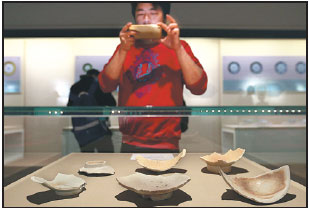Museum adds thousands of artifacts
By Wang Kaihao (China Daily) Updated: 2017-03-30 07:30|
Some cultural relics from the inventory of the Palace Museum, also known as the Forbidden City, in Beijing have been put on display for the first time.Feng Yongbin / China Daily |
The Palace Museum in Beijing, also known as the Forbidden City, said on Wednesday it has added about 55,000 cultural artifacts to its inventory, some found in storage and others uncovered while renovating a kitchen.
The museum, which was China's formal imperial palace from 1420 to 1911, now holds 1,862,690 artifacts. In 2010 there were 1,807,558 pieces in the world's most visited museum.
Some of the newly cataloged items are on display at the museum, where they'll be exhibited through April 15.
Shan Jixiang, director of the museum, said two lacquer boxes held handwritten scripts from Emperor Qianlong (1711-99) during the Qing Dynasty (1644-1911).
They are a highlight in the newly added artifacts. In addition, 105 volumes, or 25,908 pages, of poems written by Qianlong were discovered.
Newly recovered letters from celebrated painters and high officials also were released.
"More detailed academic studies followed the process of rummaging through our warehouse," Shan said. "Though we had several major statistics of our inventory before, this time we did much more work to categorize and investigate the items."
Oracle bones and porcelain pieces also were recovered. The 20,000 or so oracle bones, which were unearthed in Anyang, Henan province, can be dated back more than 3,000 years. Lyu Chenglong, a researcher at the museum participating in the survey, said they were initially collected by James Mellon Menzies (1885-1927), a Canadian missionary and archaeologist, and were later reserved by other public institutions in China before being transferred to the museum sometime between the 1950s and 1970s.
"Unlike other types of cultural relics, the oracle bones do not belong to old collections of imperial families," Lyu said.
"Most of its contents were never publicly revealed before. The new research on them was of great historical significance."
He said the broken porcelain pieces were neglected in previous academic research, but now are seen as important items for comparative studies.
Some of the items were not being warehoused when discovered.
Items were discovered when an old kitchen in the palace was being renovated, Shan said.
Shan said it is crucial to better share the museum's resources with the public. Staff members are digitally recording the collections. He said there are about 400,000 photos of cultural artifacts from the museum on its website, far fewer than the 2 million images on the British Museum's website.
"That's why we've set up a special team to take high-definition photos of the cultural relics around the clock," he said.
He said researching some items is still ongoing, but they involve items of less importance.
The agency has strict criteria to ensure collections of today will be similarly important national treasures in 200 years.
"Some museums are eager to get new artifacts, and their number of artifacts can increase by tens of thousands within a few years," he said. "That is not a good phenomenon."
According to Guan Qiang, deputy head of the State Administration of Cultural Heritage, the new inventory of the Palace Museum is part of a nationwide count of movable cultural relics starting in 2012. Guan said there are about 64 million such artifacts being stored in China's public institutions.
wangkaihao@chinadaily.com.cn
- 'Cooperation is complementary'
- Worldwide manhunt nets 50th fugitive
- China-Japan meet seeks cooperation
- Agency ensuring natural gas supply
- Global manhunt sees China catch its 50th fugitive
- Call for 'Red Boat Spirit' a noble goal, official says
- China 'open to world' of foreign talent
- Free trade studies agreed on as Li meets with Canadian PM Trudeau
- Emojis on austerity rules from top anti-graft authority go viral
- Xi: All aboard internet express












